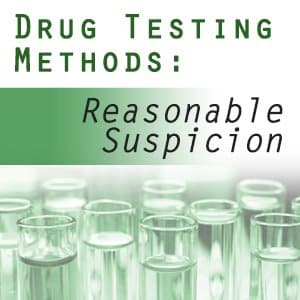DOT & FMCSA Reasonable Suspicion and Supervisory Training *
…Supervisor Training is Required to Make Reasonable Suspicion Determinations…
A supervisor is required to make a determination to test is done when there is specific, contemporaneous, articulable observations concerning the appearance, behavior, speech or body odors of the driver. In addition for controlled substances, this may include signs or effects of withdrawal from the use of controlled substances.
The requirement is that the supervisor who is making the determination has to be trained in accordance with the regulatory requirements for all the DOT Modal Agencies. This required training is to be a minimum of 60 minutes for controlled substances and an additional 60 minutes for alcohol misuse for those modal agencies required to do DOT alcohol testing. The core topics that should be included in this training are almost all behavioral training, which shall as a minimum, include indicators of speech, behavioral, physical signs and job performance signs that point to use of controlled substances or alcohol misuse. This training is directed to be given to the frontline supervisors who have day to day interaction with the employees who are in safety-sensitive positions.
Some of the key objectives for this required supervisory training are:
- Understand the important provisions of the DOT Drug-Free Workplace Program, your company policy for substance abuse and the supervisor’s role in this program,
- Determine what types of administrative and disciplinary actions are appropriate for employees who engage in illegal drug use,
- Recognize symptoms which may be drug-related and which may interfere with performance on the job, and
- Learn about drugs and their potential effects on the body and mind of the user.
What Supervisors Need to Know About Illegal and Legal Drug Abuse and Their Effects
Illegal drugs are controlled substances, possession of which is unlawful. The term “illegal drugs” does not include the use of controlled substances in accordance with a valid prescription or other use authorized by law. There will be a discussion on the subject of controlled substances and their effects in another article.
In addition, “Guidelines for Supervisors” for the documentation of employee behavior will be discussed in another article.
Supervisors Roles and Responsibilities
As supervisors, you are primarily interested in performance — getting the job done accurately and correctly as soon as possible.
When things interfere with that goal, you look for reasons that are causing the delay in job performance.
Some things that you should look for are:
a. Absenteeism
b. Late arrival – early leaving
c. Sleepiness on the job or near-accidents
d. Irritability
e. Sudden changes in behavior
f. Moodiness
g. Problems with other workers
h. Avoiding supervisors
i. Financial problems
All of these factors can lead to decreased job performance.
All of the items listed above can happen to anyone occasionally but when a problem appears with an employee who also has decreased job performance, then you, as a supervisor, must do something.
Remember, substance abuse can cause:
a. Impaired eyesight
b. Slower reaction time
c. Lessened judgment
d. Poor judgment
e. Poor coordination
There are things that inhibit supervisors from taking appropriate and immediate action. There are usually four steps that supervisors traditionally go through in solving these kinds of problems.
The first stage is Rationalization:
The following is a typical scenario for the rationalization.
- Yes, Jim has been late frequently, and yes, he is often away from his desk. He does seem to be irritable and moody and, indeed, his performance has decreased over the past few months. But Jim probably has problems at home. His kids are in high school and that’s enough to make one jumpy. It’s just a normal reaction and he’ll get over it soon. No need to call him in. He will straighten himself out.
This is the way a rationalization process works for both poor performance and abnormal behavior.
The second stage is Blocked Awareness.
In this stage, the supervisor does not see the problem because if the problem is recognized, something must be done. This is the classic denial that anything is wrong.
Several events can break through this blocked awareness pattern.
1. Pressure from your supervisor.
Your supervisor puts pressure on you to find out why productivity or performance is down.
2. A critical incident may be another break-through. This could be behavior on the job that suggests drug intoxication, such as staggering or slurred speech.
There could be threatening or abusive behavior. It could be so bad in just one instance that something must be done.
In addition it could also be abnormal or bizarre behavior. An example of bizarre behavior is the following.
- Twice a day, one employee went into each office along the corridor. First she rapped on the wall, then listened with her ear to the wall for a few seconds and then walked away without saying a word.
- When behavior is bizarre, it may well be that the employee is asking for help.
The third stage is Vacillation.
- In this phase, the supervisor will call the employee in and talk about the continued late arrivals. The employee then promises to fix that and says that he will be on time hereafter.
- This is just what the supervisor wants to hear. There may be temporary improvement but soon there is a need for a second discussion with the employee.
- The second discussion may be threatening and angry. There is a lack of consistency on the supervisor’s part and employee soon realizes that the supervisor is vacillating.
- In this situation, the employee will try to keep the vacillation going.
The fourth stage is reached when you decide to take action.
- As a supervisor, stop and think on your past experience when confronted with these types of situations. Make notes and discuss these issues with your supervisor.
Note: This will be a multi part article to ensure that all the pertinent topic areas are covered and discussed.
By: Robert C. Schoening







